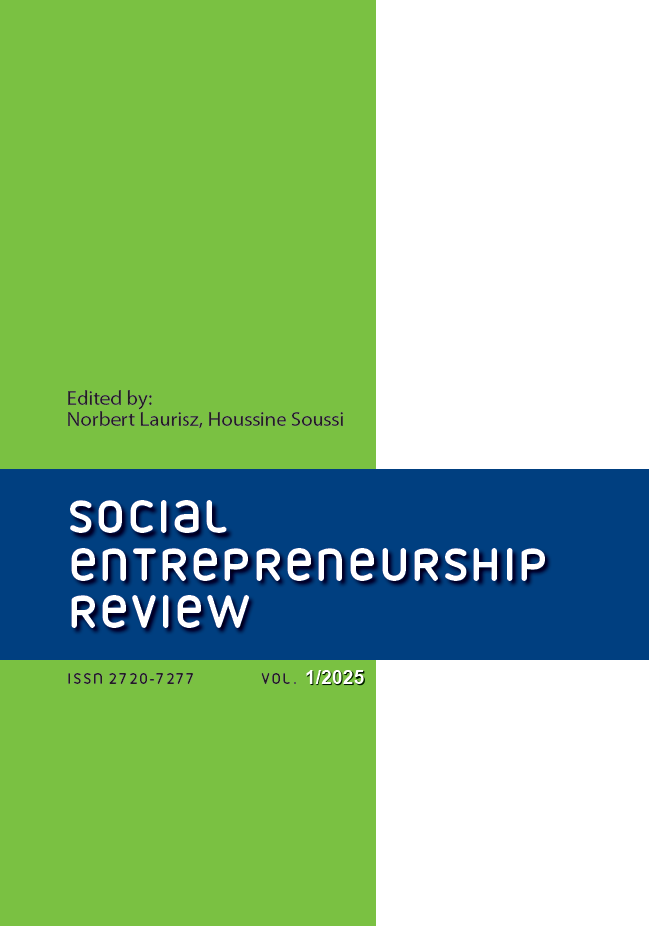Cooperation of third sector entities and business for the implementation of the circular economy
DOI:
https://doi.org/10.15678/SER.2023.1.05Keywords:
business, circular economy, third sectorAbstract
Background: The introduction of elements of the circular economy requires major structural changes in economies, the involvement of a wide range of actors, including primarily businesses. However, it is worth noting the importance of other organizations, including the so-called third sector.
Research objectives: The purpose of this article is to introduce the issue of cooperation of business and the third sector entities for the development of the circular economy.
Research design and methods: For the purpose of the research paper, the following research method was used: a classic literature review and case study.
Results: Collaboration between business and third sector providers has enormous potential for development and innovation.
Conclusions: In Polish conditions the benefits and possibilities of cooperation between business and the third sector are not properly appreciated, and they are connected with
a huge potential for the entities themselves and the possibilities of implementing the circular economy.
Downloads
References
Atasu, A., Dumas, C., & Van Wassenhove, L. N. (2021). The circular business model. https://hbr.org/2021/07/the-circular-business-model
Brears, R. C. (2018). Natural resource management and the circular economy. Cham: Palgrave Macmillan. https://doi.org/10.1007/978-3-319-71888-0 DOI: https://doi.org/10.1007/978-3-319-71888-0
Cambridge Dictionary. (n.d.). Transition. https://dictionary.cambridge.org/dictionary/english/transition
Chlebisz, A., & Żak, M. (2018). Rola trzeciego sektora społeczno-gospodarczego w kształtowaniu odpowiedzialności społecznej na przykładzie wybranych reklam społecznych. Rynek – Społeczeństwo – Kultura, 2(28), 10–14.
Chrispim, M. C, Mattsson, M., Ulvenblad, P. (2023). The underrepresented key elements of Circular Economy: A critical review of assessment tools and a guide for action. Sustainable Production and Consumption, 35, 539–558. https://doi.org/10.1016/j.spc.2022.11.019 DOI: https://doi.org/10.1016/j.spc.2022.11.019
De Angelis, R. (2018). Business models in the circular economy. Palgrave. DOI: https://doi.org/10.1007/978-3-319-75127-6
de Oliveira, C. T., & Oliveira, G. G. A. (2023). What Circular economy indicators really measure? An overview of circular economy principles and sustainable development goals. Resources, Conservation and Recycling, 190, 106850. https://doi.org/10.1016/j.resconrec.2022.106850 DOI: https://doi.org/10.1016/j.resconrec.2022.106850
DES. (n.d.). Podstawowe pojęcia. https://www.ekonomiaspoleczna.gov.pl/Podstawowe,pojecia,380.html
Deloitte. (2018). Zamknięty obieg – otwarte możliwości. Perspektywy rozwoju gospodarki o obiegu zamkniętym w Polsce. https://www2.deloitte.com/pl/pl/pages/zarzadzania-procesami-i-strategiczne/articles/innowacje/raport-zamkniety-obieg-otwarte-mozliwosci.html
EC. (2008). A European Economic Recovery Plan, Brussels, 26.11.2008, COM(2008) 800 final. DOI: https://doi.org/10.1016/S1464-2859(08)70035-X
EC. (2011). A resource-efficient Europe – Flagship initiative under the Europe 2020 Strategy. Brussels, 26.1.2011 COM(2011) 21 final.
Ekins, P., Domenech, T., Drummond, P., Bleischwitz, R., Hughes, N., & Lotti, L. (2019). The circular economy: What, why, how and where. Background paper for an OECD/EC Workshop on 5 July 2019 within the workshop series “Managing environmental and energy transitions for regions and cities”. Paris: OECD.
EMF. (2013). Towards the circular economy. Economic and business rationale for an accelerated transition. https://emf.thirdlight.com/file/24/xTyQj3oxiYNMO1xTFs9xT5LF3C/Towards%20the%20circular%20economy%20Vol%201%3A%20an%20economic%20and%20business%20rationale%20for%20an%20accelerated%20transition.pdf
EMF. (n.d.). What is a circular economy? https://ellenmacarthurfoundation.org/topics/circular-economy-introduction/overview
EP. (2015). Circular economy: definition, importance and benefits. https://www.europarl.europa.eu/news/en/headlines/economy/20151201STO05603/circular-economy-definition-importance-and-benefits
Farooque, M., Zhang, A., Thürer, M., Qu, T., & Huisingh, D. (2019). Circular supply chain management: A definition and structured literature review. Journal of Cleaner Production, 228, 882–900. DOI: https://doi.org/10.1016/j.jclepro.2019.04.303
Figge, F., Thorpe, A. S., & Gutberlet, M. (2023). Definitions of the circular economy: Circularity matters. Ecological Economics, 208, 107823. https://doi.org/10.1016/j.ecolecon.2023.107823 DOI: https://doi.org/10.1016/j.ecolecon.2023.107823
FOB. (2014). Współpraca organizacji pozarządowych z biznesem. Poradnik efektywnej współpracy. https://odpowiedzialnybiznes.pl/wp-content/uploads/2014/04/Biznes-NGO_FOB.pdf
Galvão, G. D. A., de Nadae, J., Clemente, D. H., Chinen, G., & de Carvalho, M. M. (2018). Circular economy: Overview of barriers. Procedia CIRP, 73, 79–85. https://doi.org/10.1016/j.procir.2018.04.011 DOI: https://doi.org/10.1016/j.procir.2018.04.011
Geissdoerfer, M., Savaget, P., Bocken, N. M. P., & Hultink, E. J. (2017). The circular economy – A new sustainability paradigm? Journal of Cleaner Production, 143, 757–768. DOI: https://doi.org/10.1016/j.jclepro.2016.12.048
Ghosh, S. K. (2020). Waste Management as Economic Industry Towards Circular Economy. Singapore: Springer. https://doi.org/10.1007/978-981-15-1620-7 DOI: https://doi.org/10.1007/978-981-15-1620-7
GUS. (2021). Współpraca organizacji non-profit z innymi podmiotami w 2021. https://stat.gov.pl/obszary-tematyczne/gospodarka-spoleczna-wolontariat/gospodarka-spoleczna-trzeci-sektor/wspolpraca-organizacji-non-profit-z-innymi-podmiotami-w-2021-r-,9,5.html
Härri, A., Levänen, J., & Linnanen, L. (2022). Circular economy. In Leal Filho, W., Azul, A. M., Doni, F., Salvia, A.L. (Eds.), Handbook of sustainability science in the future. Cham: Springer. https://doi.org/10.1007/978-3-030-68074-9_73-1
John, I. B., Adekunle, S. A., & Aigbavboa, C. O. (2023). Adoption of circular economy by construction industry SMEs: Organisational growth transition study. Sustainability, 15(7), 5929. https://doi.org/10.3390/su15075929 DOI: https://doi.org/10.3390/su15075929
Korhonen, J., Honkasalo, A., & Seppälä, A. (2018). Circular economy: The concept and its limitations. Ecological Economics, 143, 37–46. https://doi.org/10.1016/j.ecolecon.2017.06.041 DOI: https://doi.org/10.1016/j.ecolecon.2017.06.041
Kozielski, R. (2017). Biznes nowych możliwości – czterolistna koniczyna – nowy paradygmat biznesu. Siedliska: Doradztwo Wydawnicze GAB.
Mao, J., Li, C., Pei, Y., & Xu, L. (2018). Circular economy and sustainable development enterprises. Singapore: Springer. https://doi.org/10.1007/978-981-10-8524-6 DOI: https://doi.org/10.1007/978-981-10-8524-6
Michalak, D., Rosiek, K., & Szyja, P. (2020). Gospodarka niskoemisyjna, gospodarka cyrkularna, zielona gospodarka. Uwarunkowania i wzajemne powiązania. Łódź: Wydawnictwo Uniwersytetu Łódzkiego. DOI: https://doi.org/10.18778/8220-032-4
NAO. (n.d.). What are third sector organisations? https://www.nao.org.uk/successful-commissioning/introduction/what-are-civil-society-organisations-and-their-benefits-for-commissioners/
NEF. (2008). A Green New Deal. Joined-up policies to solve the triple crunch of the credit crisis, climate change and high oil prices. https://neweconomics.org/uploads/files/8f737ea195fe56db2f_xbm6ihwb1.pdf
OECD. (2011). Towards green growth. https://doi.org/10.1787/9789264111318-en
PARP. (2021). Monitoring innowacyjności polskich przedsiębiorstw Wyniki IV edycji badania 2022. https://en.parp.gov.pl/storage/publications/pdf/Raport_Monitoring-innowacyjnoci-polskich-przedsiebiorstw-IV-edycja_2022_20_01_2023.pdf
Salamon, L. M., & Sokolowski, W. (2014). The third sector in Europe: Towards a consensus conceptualization. Working Paper No. 02. http://thirdsectorimpact.eu/site/assets/uploads/documentations/tsi-working-paper-no-2-third sector-europe-towards-consensus-conceptualization/Conceptualiza-Wrkg-Ppr-Fnl-LMS-12-20-14.pdf
Sendzimir Foundation. (2018). https://sendzimir.org.pl/co-robimy/innowacje-dla-zrownowazonego-rozwoju/
Smol, M., Avdiushchenko, A., Kulczycka, J., & Nowaczek, A. (2018). Public awareness of circular economy in southern Poland: Case of the Malopolska Region. Journal of Cleaner Production, 197. https://doi.org/10.1016/j.jclepro.2018.06.100 DOI: https://doi.org/10.1016/j.jclepro.2018.06.100
Śmigielska, G. (2007). Kreowanie przewagi konkurencyjnej w handlu detalicznym. Kraków: Wydawnictwo Akademii Ekonomicznej w Krakowie.
UNEP (2009). Global Green New Deal. Policy brief. https://wedocs.unep.org/bitstream/handle/20.500.11822/7903/A_Global_Green_New_Deal_Policy_Brief.pdf?sequence=3&%3BisAllowed=
Williams, I. D., Curran, T., & Schneider, F. (2012). The role and contribution of the third sector in terms of waste management and resource recovery. Waste Management, 32(10), 1739–1741, https://doi.org 10.1016/j.wasman.2012.06.019 DOI: https://doi.org/10.1016/j.wasman.2012.06.019
Downloads
Published
Issue
Section
License
Copyright (c) 2023 Social Entrepreneurship Review

This work is licensed under a Creative Commons Attribution 4.0 International License.






